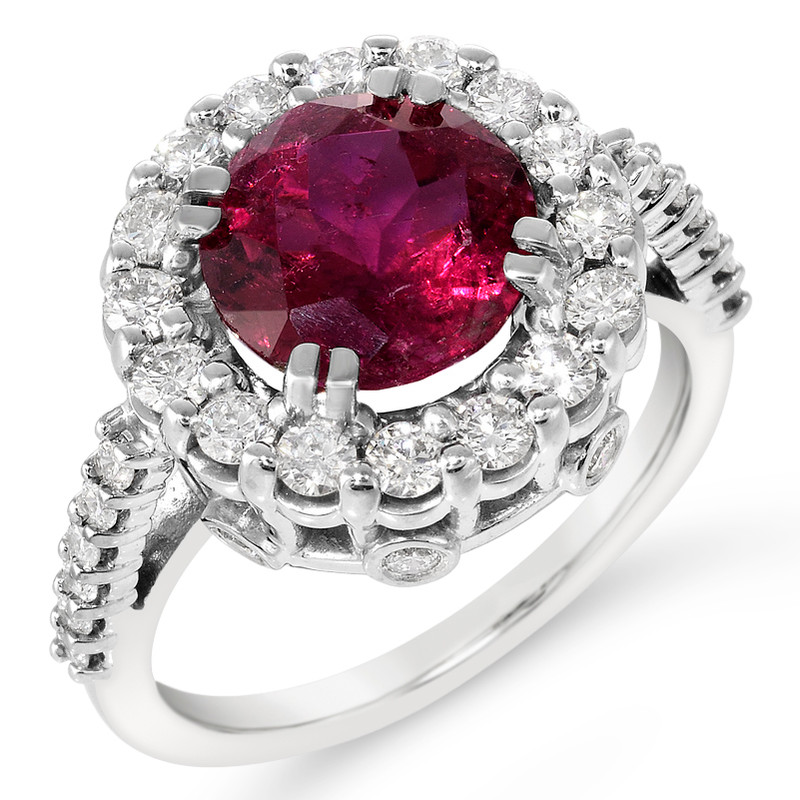You October babies have two exceptional birthstones to select from; tourmaline and opal. This blog covers colorful tourmaline, the latest addition to the October birthstones. Opal, the original October birthstone, known for its lightening-like flashes of color, is the subject of a separate blog; October Birthstone: Opal - facts and lore.
Tourmaline is said to possess the widest range of colors of any gem family. It can be found in virtually every color of the spectrum; from rich reds to pastel pinks and peach, intense emerald greens to vivid yellows and deep blues. The breadth of this gem’s color range is unrivalled. Discoveries of intense new hues in Brazil in the late 20th century further heightened tourmaline’s appeal.
Click the link to browse 100 East Fine Jewelry’s tourmaline collection. Some of our recent designs include this outstanding ring.
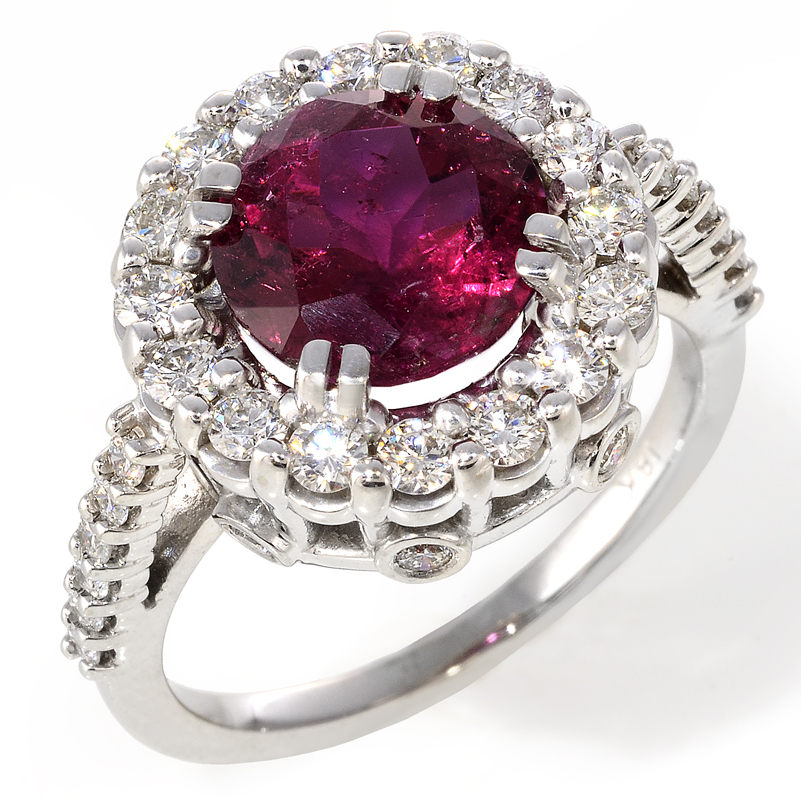
To simplify discussions with customers, members of the gem trade often create trade names to represent certaingemstones. Tourmaline has gotten its fair share of trade names, many of which are explained as follows:
- Pink to red hued tourmalines are known in the trade as “rubellite”. Unfortunately, there is no consensus among the trade on a definition. Some define rubellite as all pink and red tourmalines. Others argue only red should be called rubellite; not the pinks. Still others further limit the rubellite trade name to only the finest, most saturated purplish red to red tourmalines. Make sure when purchasing rubellite that you understand the seller's definition. Below is a photo I took at an American Gem Trade Association GemFair of a rubellite gemstone donated to the Smithsonian Institute which meets all of these definitions.
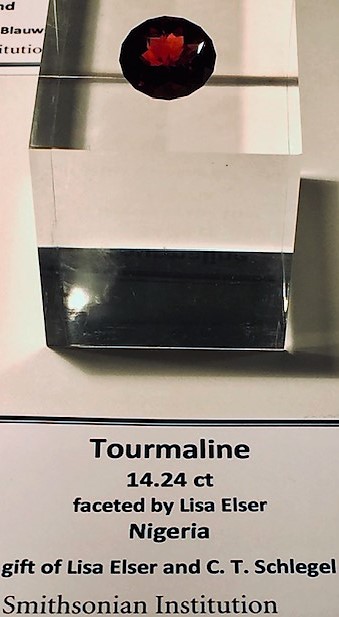
- The trade name “verdelite” is used less often today, but when used describes any shade of green tourmaline, from yellow green to pure green to blue green. However, a vibrant green tourmaline originating in East Africa goes by the trade name "chrome tourmaline". Its color can rival tsavorite garnet and sometimes even emerald.
- Blue tourmalines are sold as "indicolite".
- Intense neon green to blue to violet tourmalines are known in the trade as “Paraiba”, in recognition of the Brazilian state where they were discovered. It is vibrantly colored, highly prized, rare and expensive. Below is another photo I took at an American Gem Trade Association GemFair of a very large and expensive Paraiba tourmaline gemstone.
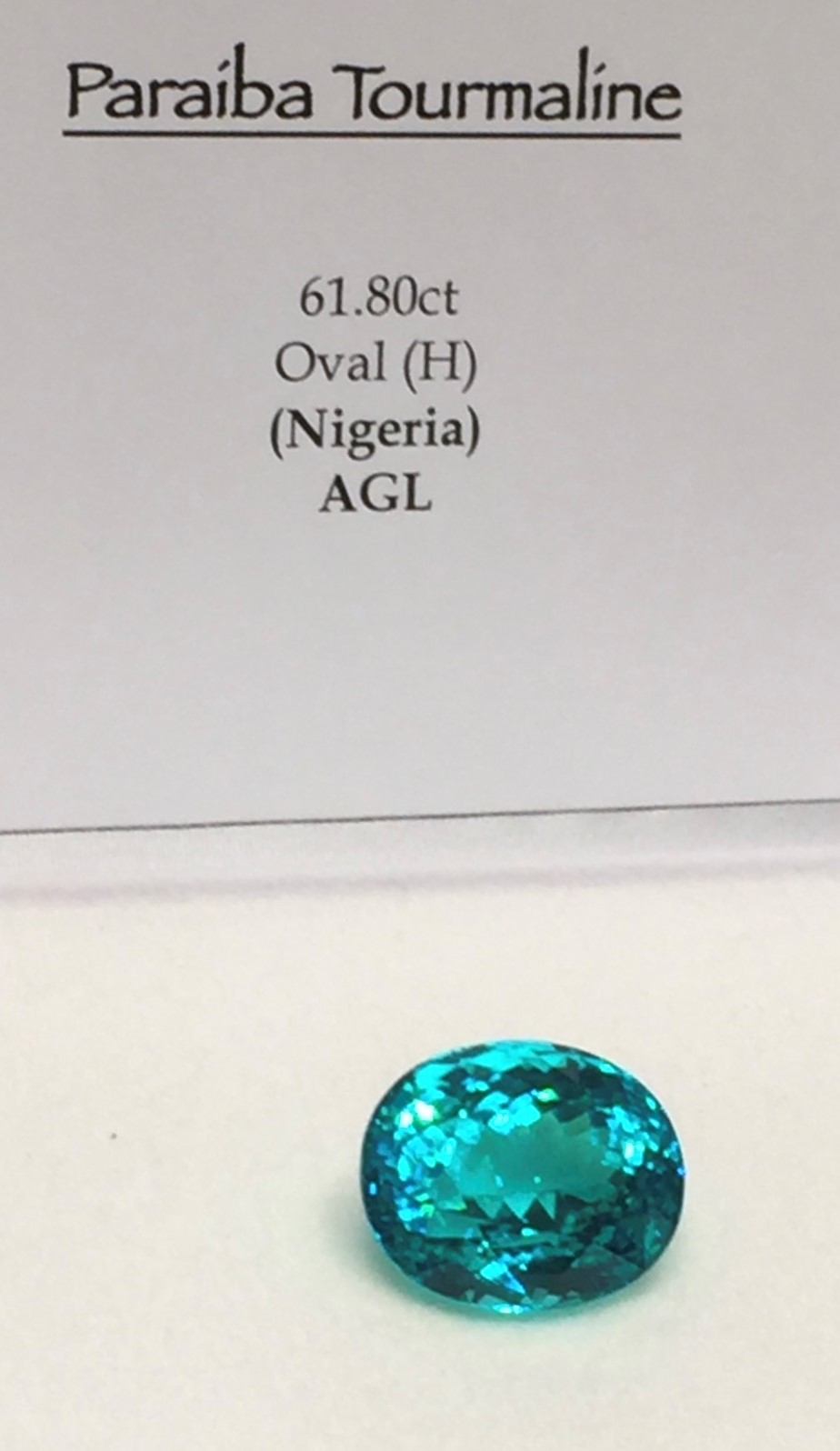
- Black tourmalines are sold under the trade name "schorl".
- Bright yellow tourmalines are called "savannah tourmaline" by some dealers.
Because of tourmaline’s endless color spectrum, most shades don’t have a particular trade name. Instead, the color name is usually used as an adjective, such as "purple tourmaline."
Tourmaline is known for color zoning, variations in depth of a color within a crystal, known as parti-color, or distinct changes of color, known as bicolor. Color zoning occurs when the concentration or composition of trace elements change during a crystal’s growth. Bicolor crystals may be color zoned along their length; starting off pink but ending up with a green tip. On the other hand, bicolor crystals can also be zoned parallel to their length, where pink crystals end up with a green overgrowth. This is known in the trade as watermelon tourmaline, one of the most well-known bicolor combinations. When cut correctly, the stone resembles a slice of watermelon with the fruit’s pink “flesh” surrounded by its green “rind”. Designers sometimes set watermelon tourmaline slices directly into jewelry pieces without faceting. While attending yet another American Gem Trade Association GenFair, I was able to capture the below photo of a watermelon tourmaline necklace that had been donated to the Smithsonian Institute.
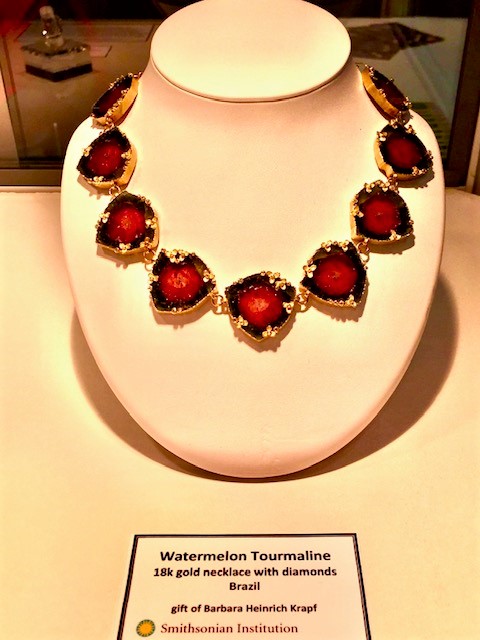
One of the most distinctive features of tourmaline is its strong pleochroism, the presence of changing depths of color or differing colors when the gem is rotated. Because of this, tourmaline is especially sought by skilled lapidaries, who can cut the gemstone in such a way that when it moves it can appear as multicolored.
On rare occasions, tourmaline displays cat’s-eye effect. This occurs most often with green, blue, or pink stones. The cat’s eye effect is caused by numerous tube-like inclusions within the tourmaline crystal. However, tourmaline’s cat’s-eye effect is less sharp than those of other fine cat’s-eye gemstones because its inclusions are larger.
Some unpolished tourmaline crystals are quite beautiful, which makes them a favorite of mineral collectors. Tourmaline also has a couple of unique physical characteristics. Its crystals can generate electricity when heated, known as being pyroelectric. Also, a tourmaline crystal can accumulate an electric charge when it’s placed under a mechanical stress, known as piezoelectricity.
Tourmaline also serves as the eighth anniversary gemstone.
History and Lore
People have probably used tourmaline as a gemstone for centuries, but just didn’t know it. Prior to the creation of modern mineralogy, many red gemstones were often classified as ruby, green was emerald and blue was sapphire. Tourmaline possesses such a dazzling range of colors, it was often misidentified as these and other gems.
This confusion was first documented in South America in the 1500’s when Portuguese explorers acquired green and blue tourmaline from locals and while panning for gold. They believed those colorful stones to be emeralds and sapphires. Once transported to Portugal, they were cut into gemstones and used to make “sapphire” and “emerald” jewelry for royalty and wealthy elite.
The origin of tourmaline’s name further added to the confusion. In the early 1700’s, Dutch traders returning from Ceylon (currently Sri Lanka) called unfamiliar multicolored, water-worn pebbles found in the country’s gem gravels “toramalli”, Sinhalese (the Ceylon language) meaning “mixed gems.” Thus, any crystal not recognized as a ruby or sapphire simply became “toramalli.” The confusion lived on for decades until scientists recognized tourmaline as a distinct mineral species in the late 1700’s. As the science evolved, gemologists determined these “toramalli” were actually tourmaline, as well as a host of other gem varieties.
One prominent example of tourmaline’s mistaken identity is the history of “Caesar’s Ruby” pendant. This pendant features a roughly 260 carat “ruby” which is currently part of the Russian crown jewels. Documents referencing the gemstone date back to late 16th century France. The stone was traded among French, Swedish and Russian royalty for centuries. While overseeing an inventory of the Russian crown jewels in 1922, the stone was examined by a mineralogist, who identified it as rubellite tourmaline.
Beginning in the late 1800s, a series of tourmaline discoveries occurred in Brazil. Since then, millions of carats of tourmaline have been produced from there in a wide range of colors, including significant quantities of bicolor material. This diverse stream of Brazilian material has been an important component of the worldwide gem and jewelry market.
Commercial tourmaline mining began in the US state of Maine in 1821; where it grew to become an important source of pink and mint green colors. The most important US tourmaline source was in southern California, where deposits of primarily pink tourmaline were discovered in 1898. Tourmaline became known as an American gem through the efforts of Tiffany and Co. gemologist George F. Kunz. His writings, which praised the Maine and California tourmaline deposits, contributed to the US becoming a major factor in tourmaline’s popularity. From 1898 until 1914, tourmaline became the most important gem material mined in California, with most of it being exported to China.
Over 100 tons of pink gem-quality tourmaline from San Diego County, California was shipped to China to satisfy the Empress Dowager Tz'u His’s love for pink tourmaline. Chinese craftsmen made it into snuff bottles, carvings and jewelry. US mines became so dependent on Chinese trade that between Tz'u His’s death in 1908 and the collapse of the Chinese government in 1912, US tourmaline trade with China also collapsed, shutting down some San Diego county mines. Today, small-scale mining continues in San Diego County, resulting in sporadic tourmaline supplies.
Global tourmaline supply began to expand during the first half of the twentieth century with the discovery of large deposits in Brazil. Beginning in the 1950s, additional discoveries occurred in various countries around the world, including Madagascar and Afghanistan. In 1989, neon blue and green gemstones discovered in the Brazilian state of Paraiba electrified the gem world. Initial worldwide reception was enthusiastic, especially in Japan, where demand was insatiable. Fueled by its rarity and strong demand for its exceptionally saturated hues, prices soared. Tourmaline was rarely seen in high-end jewelry until the discovery of vividly colored Paraiba tourmalines changed the way the gem market perceived tourmaline.
Recent discoveries of tourmaline deposits in Mozambique, Namibia, Nigeria, Pakistan, Tanzania, the United States and other countries are providing the market with a constantly changing supply of tourmaline gems and mineral specimens. The global gem market has come to appreciate tourmaline thanks to Paraíba, rubellite and indicolite.
Tourmaline’s lore includes the belief it possesses healing powers, with different colors associated with unique properties. Black tourmaline is believed to protect the wearer and give a sense of self-confidence. Pink tourmaline embodies love and is associated with compassion and gentleness. Green tourmaline promotes courage, strength and stamina.
Use in Jewelry Today
Tourmaline is commercially important in today’s gemstone market. Because of its myriad combinations of colors, sizes, and quality, it can be found in every price range, from commercial grade to superb high-end pieces. Finished tourmaline gemstones are cut into both common and unusual shapes and large, even spectacular, sizes. However, such excessively large pieces remain quite rare. Below is a photo of a polished tourmaline gemstone, courtesy of Gemological Institute of America.
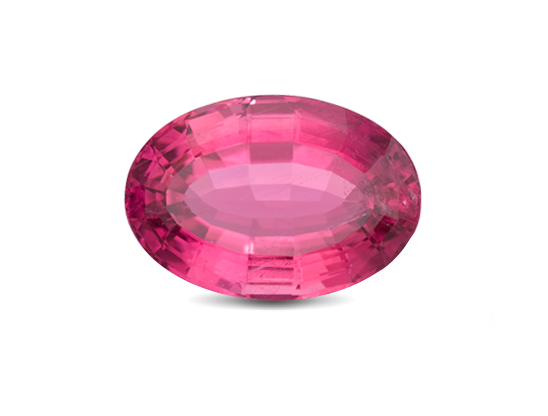
Today’s selection of tourmaline jewelry is equally diverse. A favorite of unconventional designers and lapidaries, tourmaline also enhances more traditional designs. Jewelry designs featuring tourmaline are limited only by the designer’s imagination. Suites of tourmaline stones are often made into matching jewelry sets. Unlike many gem quality crystals, tourmaline’s unique structure allows it to be set into jewelry as-is, without further faceting.
Rubellite’s pink to red hues and depth of color can approach those of ruby and pink sapphire. Pink tourmaline’s range of sizes and good clarity make it a market favorite. One of the most sought-after rubellites is the vivid purplish red hue, which can be found in large sizes. Rubellite’s popularity may result, in part, from being used as an affordable alternative to the increasingly expensive ruby.
Blue and green tourmaline are deservedly popular in today’s market. Chrome green tourmaline can be a lower cost alternative to tsavorite garnet or emerald. Chrome tourmaline is available in sizes up to five carats while tsavorite and emerald are rare above two carats.
Prices for the best Paraiba tourmalines easily surpass all other tourmalines, as well as many other gem species, due to their attractive blue, green and violet hues, high saturation, and rarity.
Tourmaline’s hardness and resistance to scratching, chipping, and cracking, make it an excellent choice for everyday wear. It’s usually stable enough to withstand light and most chemicals, but heat can be damaging. The use of ultrasonic and steam cleaners is not recommended. It is best cleaned with warm, soapy water and a soft brush, a single, safe method we recommend for cleaning all gemstone jewelry. For additional details, please read our blog; Cleaning Fine Gemstone Jewelry. To learn about caring for your fine jewelry, please read our blog; Caring for Fine Gemstone Jewelry.
Well-formed tourmaline crystals are also highly valued by mineral collectors. Specimens with attractive colors and crystal forms can sell for many thousands of dollars.
Color Characteristics and Treatments
Tourmaline’s range of colors is unparalleled. In addition to possessing a rainbow of hues, it has a wide array of intensities and tones which run the gamut from intense emerald greens, deep sapphire blues and rich ruby reds to pastel pinks, peaches, yellows, green-blues, cinnamon browns. When factoring in the effects of color zoning and pleochroism, tourmaline is available in more colors and color combinations than any other gem species.
Tourmaline is a large family of minerals which share a common crystal structure and similar physical properties but which vary in chemical composition. Its chemical make-up is one of the most complex of all minerals. Tourmaline’s mineral family is made up of more than ten species, five of which contain gem-quality varieties. Tourmaline’s colors have many different causes. Traces of iron, and possibly titanium, cause green and blue colors. Manganese produces reds and pinks, and possibly yellows. Some pink to red and yellow might owe their hues to color centers caused by radiation, either natural or laboratory-induced.
Green Tourmaline – Green, colored by traces of iron, is tourmaline’s most common hue. Its pastels provide the market with pleasing alternatives to the deep, rich hue of emerald and the softer green of peridot. At their best, green tourmalines are transparent, brilliant, and clean. The most popular green tourmalines, seafoam and mint colored, can command prices comparable to rubellite. Despite their light colors, manufacturers apply fancy cutting styles to them to bring out the life in these stones. Strong pleochroism and large sizes also play a role in their popularity.
Known in the trade as chrome tourmaline, chromium and sometimes vanadium colored green gems from eastern Africa combine intense color with small size. This is unlike most tourmalines which need to be large to show strong color. Their hues range from strong bluish green to very slightly yellowish green and can serve as cost-efficient alternatives to emerald and tsavorite garnet.
Blue Tourmaline– Blue tourmaline, aka indicolite, mostly derives its color from traces of iron. Its blue color can be strong and vivid or less saturated and grayish. It can range in tone from light to dark, but is typically found in darker tones. Blue tourmaline is normally less transparent and less brilliant than green tourmaline. Its blue hue is often modified by green, but blue must be the predominant color.
Paraiba Tourmaline – The rare Paraiba tourmaline, colored by copper, comes in a range of green to blue to violet hues. Named for the Brazilian state where it was discovered in 1989, Paraíba tourmaline’s striking neon blues and greens electrified the gem world. Its unique fluorescent glow instantly set it apart from other tourmalines. Initial worldwide reception to the gem was wild, especially in Japan, where demand for fine-colored stones was insatiable. Prices for top quality Paraiba in sizes between 3 and 5 carats, quickly exceeded prized rubellite reds and chrome greens.
This unique gem originally came from one area in the northeast corner of the state of Paraíba. Researchers believe its crystals formed under very unusual conditions, with large amounts of color-creating trace elements, like manganese and copper. Paraíba tourmaline is unusual in that while copper colors some other gems, it’s not a coloring agent in any other tourmaline variety. In some specimens, there’s so much copper that inclusions of almost pure native copper can be found in the gem’s interior.
Although buyers covet all Paraiba colors, blue and violet appeal the most. During Paraíba’s brief history, dealers have resigned themselves to the gem’s extreme scarcity. New discoveries elsewhere in Brazil and in eastern Africa create the possibility that viable, commercial sources might one day supply the trade with more material. Unfortunately, new source points also raise questions about the use of the name Paraíba.
Red and pink tourmaline – With colors from purplish red and pink to orangy red and pink, these tourmalines have the same color range as ruby and pink sapphire. Red and pink tourmaline primarily derive their color from manganese, but some are colored by titanium or color centers induced by man-made or natural radiation. Most red has a strong purplish component. Pink ranges from light pastel shades to vibrant pinks described by some as hot pink or bubblegum pink. The best pink rivals the vibrant hues of top quality pink sapphire. Pink tourmaline is consistently available in larger sizes. Pink to red tourmaline often has more visible inclusions than green to blue varieties.
Clarity - Tourmaline crystals grow in an environment rich in liquids, with some of those liquids often captured as inclusions during crystal growth. The most typical inclusions resemble thread-like cavities that run parallel to the length of the crystal. Under magnification, you can see the cavities are filled with liquid or gas bubbles. Growth tubes, long hollow tubes often capped with minute mineral crystals, are also common tourmaline inclusions. If they’re numerous enough, and the rough is correctly cut, they can cause a cat’s-eye effect.
While it’s not unusual for pink and red
tourmalines to display eye-visible inclusions, green tourmalines are expected
to be free of them. Dealers usually tolerate eye-visible inclusions as long as
the stone’s color is strong and attractive. Although liquid inclusions are less
visible in stones of intense color, stones with prominent whitish inclusions,
no matter how vibrant the color, are less desirable. In general, the more visible the inclusions, the more
the value drops.
Treatments and Synthetics - Reputable dealers, like 100 East Fine Jewelry,
disclose all gemstone treatments to prospective buyers. Tourmalines are
subjected to a number of treatments. The two most common are heating and
irradiation. Heat is used to convert less marketable brownish purple tourmaline
to rose or pink colors. Heating can also be used to improve color in
some red and pink tourmalines. Reds may also be irradiated.
Many green and blue tourmalines are heated after cutting and polishing which usually
lightens and brightens them. Some Paraíba tourmaline is both heated and
irradiated to improve color. Heating and irradiating are stable and undetectable
treatments and the resulting colors match natural. Stones with abundant liquid
inclusions cannot withstand heat treatment, but can be irradiated. Irradiated
tourmaline might fade over time. Some pink have surface-reaching fractures,
which makes dying a possibility.
Tourmaline is not manufactured synthetically.
Formation, Mining and Cutting
Most gem quality tourmaline forms in pegmatites, rare igneous rocks rich in exotic elements. Because of the nature of pegmatites, many tourmaline mines produce a variety of gem colors. Well-formed tourmaline crystals are quite distinctive. They are normally elongated with a rounded triangular cross-section, appropriately referred to as pencils. No other common mineral has three sided prisms. The crystals also contain striations, fine grooves which run lengthwise along the exterior. Tourmaline crystals can be quite large, which allows cutters to cut large gemstones. Tourmaline crystals are also a favorite of mineral collectors. Below is a photo of a tourmaline crystal, courtesy of the Gemological Institute of America.
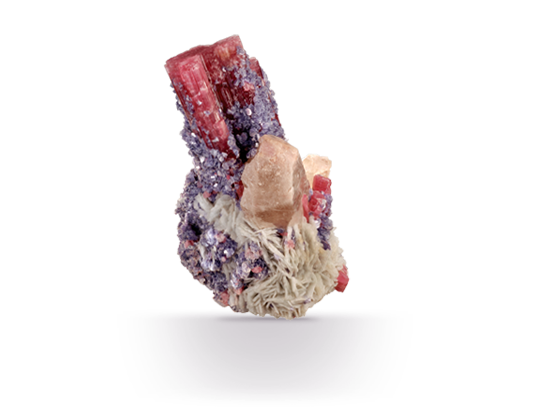
Tourmaline is mined in a number of locations around the world, with Brazil supplying the majority of the world’s gem-quality material. The Brazilian state of Minas Gerais has more tourmaline-producing pegmatites than anywhere else on earth and hundreds of mines which supply the widest color variety of any single location. In 1989, electric green, blue and violet tourmalines entered the gem market from pegmatites in Brazil’s Paraíba State.
Besides Brazil, fine gem-quality tourmaline can be found in Africa, with important producers being Madagascar and Mozambique. Other African nations supplying tourmaline include Zambia, Namibia, Tanzania, and Kenya. Nigeria has also seen recent production of tourmaline in unusual colors and sizes. Additional deposits were also found in Myanmar, Afghanistan, Pakistan, eastern Russia and the United States.
Brazil’s state of Minas Gerais is a major source of the finest red tourmaline, as are Madagascar and Afghanistan.
Green and blue tourmaline come from Brazil, Afghanistan, the US and Africa. Chrome green comes mostly from the East African countries of Tanzania and Kenya. Some also is mined in Myanmar.
Copper-bearing tourmalines that resemble the vibrant, intense colors of Brazil’s Paraiba region were discovered in Mozambique and Nigeria In the early 2000s. The 2001 discovery of almost identical material to Paraiba in Mozambique spurred a debate over its name. Mozambique cuprian tourmaline is mined in much larger quantities than material sourced from Paraíba and the price points are distinctly lower. Since the two materials overlap mineralogically, origin determination presented some challenges for gem labs. Although it is accepted by the Laboratory Manual Harmonization Committee (LMHC), purists disagree as to whether or not Mozambique cuprian tourmaline should be called Paraíba, since it is an origin name.
In
the United States, both Southern California and Maine have several pegmatite
districts. For more than a century, they sporadically yielded varying
quantities of tourmaline.
Cut- Tourmaline crystals are often long and thin. The pencil-like configuration and the crystal’s pleochroic properties combine to define the finished gemstone’s shape and proportions. Often it results in slender rectangular finished stones, frequently in non-standard sizes. Although they’re very attractive, many gem buyers prefer stones with standard dimensions as they’re easier to set in standard mountings.
Paraiba tourmaline is almost always custom cut due to the rough’s high value. Usually faceted into pear and oval shaped brilliant cuts and rarely in sizes over one carat; color is the key factor not size. If a dealer has to choose between a larger Paraiba or a more vividly colored one, all other factors being equal; color normally wins.
Like other cat’s-eyes, tourmaline stones have to be cut as cabochons to bring out the effect.
Famous Tourmalines include:
Caesar’s Ruby pendant, seen below, features an approximately 260 carat red tourmaline, as discussed above. It is currently in the collection of the Kremlin State Diamond Fund. The tourmaline is shaped like a berry or a bunch of grapes and is 4 cm x 2.7 cm x 2.3 cm in size. The color and unusual shape of the tourmaline is accentuated with green enamel leaves against a gold background.
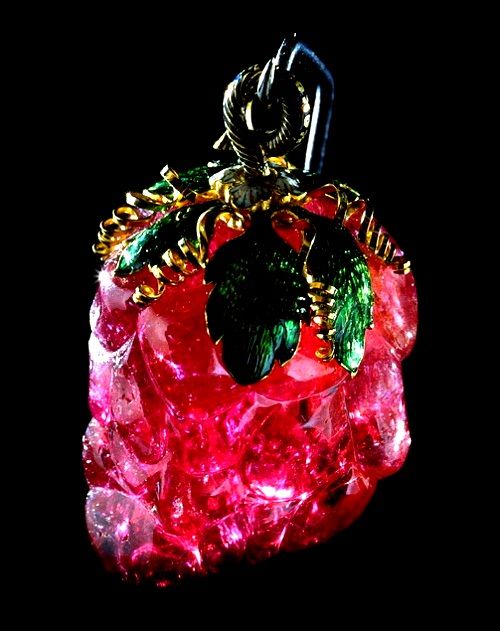 Photo Credit: https://www.pinterest.com/SweetpeaSparky/sweetest-...
Photo Credit: https://www.pinterest.com/SweetpeaSparky/sweetest-...
The 1730 Anna Ioannovna Crown, part of the Russian Crown Jewels, is set with a large red tourmaline.
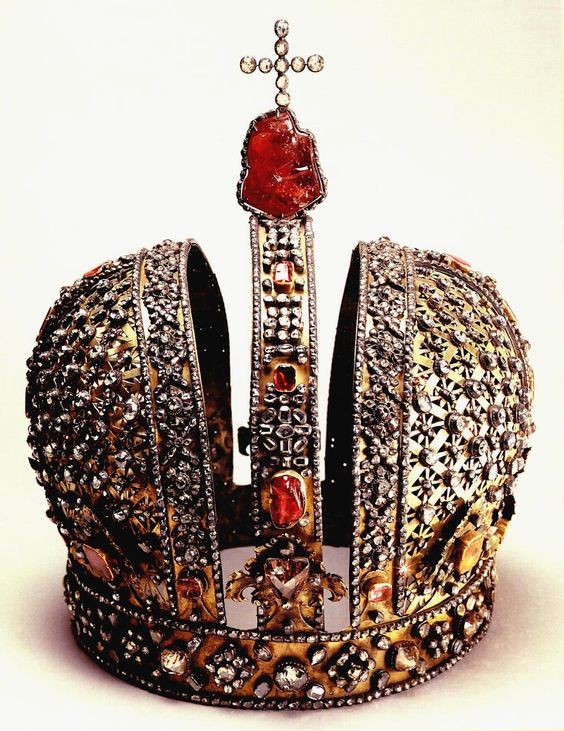 Photo Credit: https://www.pinterest.com/pin/424816177322995375/
Photo Credit: https://www.pinterest.com/pin/424816177322995375/
The Lily Safra poppy flower brooch with a diamond and pink and green tourmalines sold for $1,273,320 at Christie's Geneva in 2012.
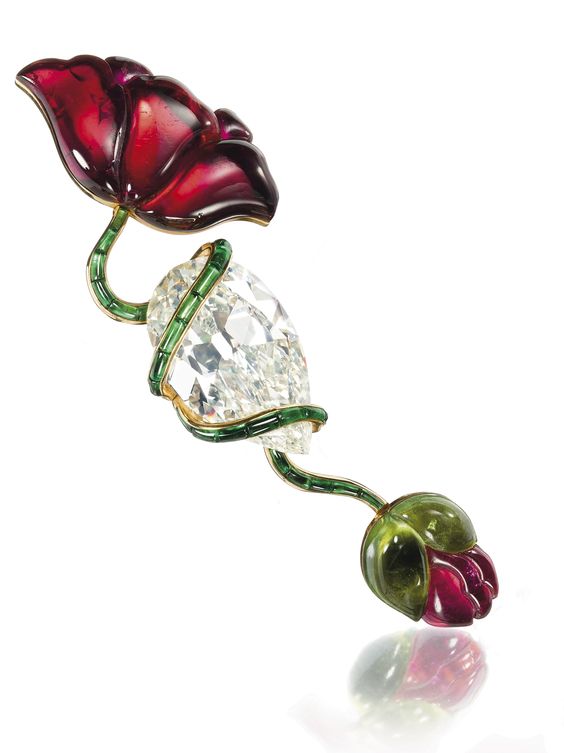 Photo Credit: https://www.pinterest.co.uk/pin/35951398273772099...
Photo Credit: https://www.pinterest.co.uk/pin/35951398273772099...
Content Credit to American Gem Trade Association, Gemological Institute of America and Gemworld International.

